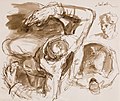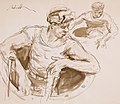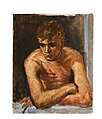Edward Melcarth
Edward Melcarth (January 31, 1914 – December 14, 1973),[1] was born as Edward Epstein[2] in Louisville, Kentucky to Eva Epstein (born Ehrmann) and Edward "Eddie" Epstein Sr., a wealthy Jewish family.[3] His grandfather was a noted distiller and liquor dealer, Hilmar Ehrmann[3] and he was the nephew of Herbert B. Ehrmann and Sara R. Ehrmann.[4] After his father died in February 1920,[3] his mother, whose family discouraged her from becoming an opera singer,[5] remarried to Sir Reginald Mitchell Banks, KC, and Member of Parliament for Swindon.[6]
Edward changed his last name to Melcarth on February 10, 1936,
While he presented himself as openly homosexual, he did marry Joan Beer, a woman also known as Hansi Kostolany,[10] in Paris during the summer of 1939.[7] The couple eventually divorced in 1944 and he did not remarry.[7] During World War II, he served as a seaman in the United States Merchant Marine.[7]
Career

Melcarth left Kentucky to pursue his personal interests and career, studied at Harvard University, the Chelsea College of Arts,[1] and Stanley William Hayter's Atelier 17 in Paris, a notable print studio where European modernists gathered and produced limited editions.[11] In the Fall of 1951, he taught at the University of Louisville.[7] The following year, he left the United States for Italy in February.[7] Melcarth later returned to the United States in November 1952.[7] By 1953, he was residing in New York City and it became his primary residence.[7]
His work did not follow
Along with painting, Melcarth was also a photographer
Melcarth's friends and patrons included:[17]
- Peggy Guggenheim
- Gore Vidal
- Tennessee Williams
- Chick Austin
- R. Kirk Askew (whose portrait he painted in 1941)
- William T. Kempfer
- William Inge
- Van Day Truex
- Edgar Kaufmann, Jr.
- James Whitney Fosburgh
- Whitney Warren
- Virgil Thomson
- Leonard Whiting[18]
His works are in the permanent collections of:[11]
- Whitney Museum of American Art
- Museum of Fine Arts Boston
- Art Institute of Chicago
- Detroit Institute of Arts
- Kinsey Institute
- Crystal Bridges Museum of American Art[19]
- Metropolitan Museum of Art[20]
- Yale University Art Gallery[21]
- Princeton University Art Museum[22]
- Forbes Collection[23]
He taught at Parsons School of Design, Columbia University, the University of Washington, the University of Louisville, and the Art Students League.[11][24] His awards included a grant from the Institute of Arts and Letters in 1951, and its Childe Hassam purchase award in 1965, the Altman prize of the Chicago Art Institute in 1950, first prize for figure from the National Academy of Design in 1964 and its Thomas B. Clarke award in 1969.[25] He was recognized as one of the top 19 young American artists by Life (magazine) in 1950, and they reproduced one of his paintings in color.[26]
FBI investigation
In January 1952, the United States Federal Bureau of Investigation opened an investigation against Melcarth due to potential Communist ties and his paintings of "scenes of leftist progressive aspect."[7] The FBI files, which can be obtained through a Freedom of Information/Privacy Acts (FOIPA) request, detail information about his life and involvement with the Communist Party.[7] Melcarth joined the Communist Party in 1944 and remained an active member until 1948, when he departed due to a minor disagreement with the official line on Yugoslavia, where Melcarth had visited in 1938.[27] Following this initial involvement, it is said that he carried his Communist membership card with him and aligned with communist ideology for a majority of his life.[7]
As part of his support for
Notable work
Likely to try to avoid the draft, Melcarth moved to Iran in the early 1940s to work as a truck driver.[16] During this time, in November 1943, Melcarth illustrated for Fortune (magazine) on the construction project to build a road from the Persian Gulf to the Caspian Sea. The Fortune commission is seen as an early boost to his career and provided one of the most lively reportage features in the magazine as it surveyed the War.[29]
In 1957, Melcarth painted a ceiling mural for the
Artwork
-
Edward Melcarth, Last Supper, c. 1960s, oil on canvas
-
Edward Melcarth, Rape of the Sabines (no date), oil on canvas, 60 x 85.5 inches
-
Edward Melcarth, Excavation, oil on canvas.
-
Edward Melcarth, Manhole, 1959, oil on canvas, 70 × 70 in. Crystal Bridges Museum of American Art.
-
Edward Melcarth, "Study for Manhole"
-
Edward Melcarth, "Study for Manhole"
-
Edward Melcarth, Man Leaning On Windowsill, oil on canvas, 20 x 16 inches
-
Edward Melcarth, Male Portrait Dark Hair, oil on canvas, 13 x 16 inches
-
Edward Melcarth, Blond Youth with Brown Jacket, oil on canvas, 22 x 16 inches
-
Edward Melcarth, Portrait of Blond Youth in Turquoise Jacket, oil on canvas, 20 x 16 inches
-
Edward Melcarth, Blond Man with Blue and Green Shirts, oil on canvas, 18 x 14 inches
-
Edward Melcarth, The Hanging, oil on canvas, 17 x 13 inches
Legacy
The lack of recognition given to Melcarth during his life is speculated to be because of his identity as an openly gay, Jewish, and communist man.[15] Melcarth, although previously overlooked by art historians as an influential figure of modern art,[5] has received recent recognition for his contributions to queer art.[15] Today, Melcarth's work is held in notable collections and he is receiving a resurgence as the subject of recent critical writing and analysis.
Melcarth mentored many artists during his career, including Robert Morgan, Paul Resika, and Richard Taddei.[35][36] Morgan studied painting under Melcarth at the Art Student's League and was invited by him to Venice in 1970 to assist him with completing several large paintings and a sculpture group commissioned by Malcolm Forbes.[37] Taddei assisted Melcarth with the painting of the trompe l’oeil mural at the Pierre Hotel[38] and, in 1972, traveled to Italy where he lived and worked alongside Melcarth.[39] Resika met Melcarth in Italy when he moved in next door[40] and, in return for Resika's help painting a mural, Melcarth offered to instruct him in figure composition and in how to paint in the style of the Venetian masters.[36] In 1952, Resika and Melcarth exhibited together in Venice and the exhibition was mentioned in TIME (magazine).[28]
Malcolm Forbes and his son, Christopher Forbes were avid collectors of Melcarth's work throughout his career.[2] After Melcarth's death in 1973, the bulk of his work remained unsold and in storage, until finally acquired by the Forbes Collection in 1980 and 1991.[17]
In 1995, Virgil Burnett published Edward Melcarth: a hercynian memoir, a biography and collection of work of Edward Melcarth, who Burnett studied under at Columbia University.[41][42]
In 2018, in conjunction with the Faulkner Morgan Archive, two exhibits took place in Lexington, KY that showcased Melcarth's work. Edward Melcarth: Points of View, was hosted by the
In 2021, Aaron Lecklider published Love's Next Meeting: The Forgotten History of Homosexuality and the Left in American Culture which features Melcarth's Last Supper (ca. 1962) on the cover, and discusses his work in the introduction.[27]
References
- ^ ISSN 0362-4331. Retrieved 2024-03-03.
- ^ a b c d e "Welcome home, Edward!". FMA. 2019-09-13. Retrieved 2024-03-02.
- ^ a b c "Edward Melcarth - Biography". www.askart.com. Retrieved 2024-03-03.
- ^ "Herbert B. Ehrmann". geni_family_tree. 2022-04-28. Retrieved 2024-03-03.
- ^ a b c d e f Gómez, Edward M. (2018-02-10). "Rediscovering Edward Melcarth, a Gay, Communist Visionary". Hyperallergic. Retrieved 2024-03-02.
- ISSN 0362-4331. Retrieved 2024-03-03.
- ^ a b c d e f g h i j k "FBI surveillance document". Retrieved 2024-03-02.
- ^ Networks, Hornet (2021-09-14). "This Queer Communist From Kentucky Radicalized the Male Body In His Art". Hornet. Retrieved 2024-03-02.
- ^ "Style Eye-Con". Minnie Muse. Retrieved 2024-03-03.
- ^ "Hansi Kostolany". geni_family_tree. 2022-05-01. Retrieved 2024-03-03.
- ^ a b c d "UK Exhibit Explores Kentucky Artist's Radical Perspective". UKNow. 2018-01-11. Retrieved 2024-03-02.
- ^ "About The Art: Art Since 1950: Gallery 12" (PDF). Ackland Art Museum.
- ^ Barnes, Arden. "FBI-blacklisted, Louisville artist makes his long-deserved debut at UK Art Museum". Kentucky Kernel. Retrieved 2024-03-12.
- ^ "Past Exhibitions | College of Fine Arts". finearts.uky.edu. Retrieved 2024-03-12.
- ^ a b c d "Exhibitions: Edward Melcarth KY". Institute 193. Retrieved 2024-03-02.
- ^ a b c d "queerplaces - Edward Melcarth". www.elisarolle.com. Retrieved 2024-03-02.
- ^ a b c d e Griffey, Erin, and Barry Reay. “Sexual Portraits: Edward Melcarth and Homoeroticism in Modern American Art.” History Workshop Journal, no. 73, 2012, pp. 66–94. JSTOR, http://www.jstor.org/stable/23277781.
- ^ "Edward Melcarth sculpting Leonard Whiting, ca. 1969, from the Edward Melcarth papers, [ca. 1930-1974] | Archives of American Art, Smithsonian Institution". www.aaa.si.edu. Retrieved 2024-03-03.
- ^ "Houseguests: American Art from the Art Bridges Collection Loan Partnership". Ackland Art Museum. Retrieved 2024-03-03.
- ^ "Edward Melcarth | Il Trevisano". The Metropolitan Museum of Art. Retrieved 2024-03-03.
- ^ "Private Worlds | Yale University Art Gallery". artgallery.yale.edu. Retrieved 2024-03-03.
- ^ "Edward Melcarth". artmuseum.princeton.edu. Retrieved 2024-03-11.
- ^ "UK Exhibit Explores Kentucky Artist's Radical Perspective". UKNow. 2018-01-11. Retrieved 2024-03-02.
- ^ "Past Instructors and Lecturers of the Art Students League". Art Students League.
- ^ "Edward Melcarth, Artist Taught at Schools Here". The New York Times. December 16, 1973.
- ^ "19 Young American Artists". Life. March 20, 1950. Retrieved March 2, 2024.
- ^ ISBN 978-0-520-39558-9.
- ^ ISSN 0040-781X. Retrieved 2024-03-12.
- ^ "FORTUNE ILLUSTRATION, Edward Melcarth, Road to Russia, Novem,ber 1943". www.fulltable.com. Retrieved 2024-03-03.
- ISSN 0362-4331. Retrieved 2024-03-03.
- ISSN 0362-4331. Retrieved 2024-03-03.
- ^ "Historic NYC Hotels | History | The Pierre NY". The Pierre, a Taj Hotel, New York. Retrieved 2024-03-02.
- ISSN 0362-4331. Retrieved 2024-03-02.
- ^ AFineLyne (2016-07-25). "Inside The Pierre Hotel's Recently Restored, Stunning Rotunda Room in NYC". Untapped New York. Retrieved 2024-03-02.
- ^ Lewandowski, Taylor (2021). "Richard Taddei on His Mentor, Edward Melcarth". The Gay & Lesbian Review Worldwide. 28 (5).
- ^ a b Weber, Bruce (2013). SEE IT LOUD: Seven Post-War American Painters (PDF). National Academy Museum.
- ^ "Fleeting Beauty - Robert Morgan". www.robertmorganvenice.com. Retrieved 2024-03-12.
- ^ "Richard Taddei, Trompe l'oeil, Mural Artist, New York, NY". www.richardtaddei.com. Retrieved 2024-03-12.
- ^ ultrawolvesunderthefullmoon (2015-04-09). "Richard Taddei". ultrawolvesunderthefullmoon. Retrieved 2024-03-12.
- ^ Goldberg, Ira (2010-04-01). "Paul Resika Interview | A Painter's Beginnings | LINEA | Art Students League". LINEA. Retrieved 2024-03-12.
- ^ "Pasdeloup Press · The Material and Immaterial Worlds of Virgil Burnett". ds-omeka.haverford.edu. Retrieved 2024-03-03.
- ^ Horowitz, Sarah. "Research Guides: Virgil Burnett Collection (HC): Pasdeloup Press". guides.tricolib.brynmawr.edu. Retrieved 2024-03-03.
- ^ Johnson, J.P. (August 2016). "From the Archive: An LGBTQ History of Kentucky". LinQ. Lexington, KY: Pride Community Services Organization. p. 17.












